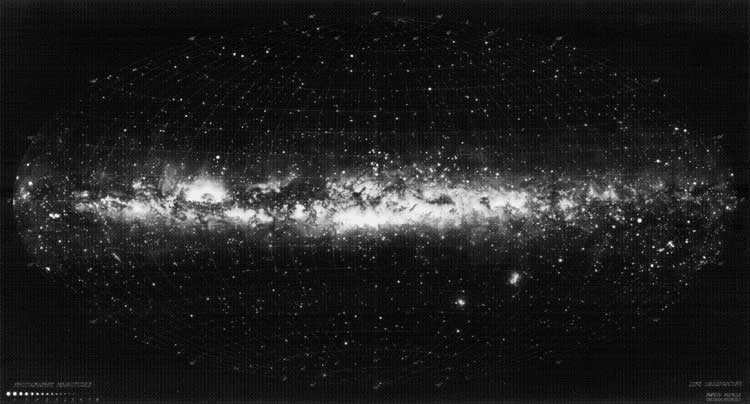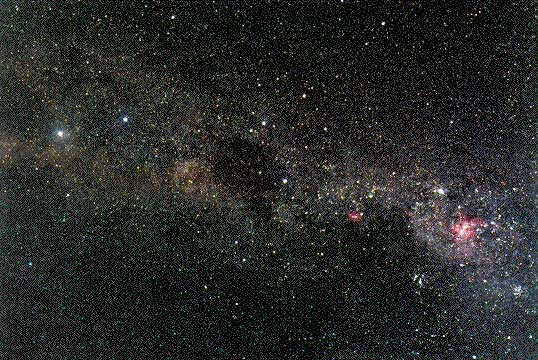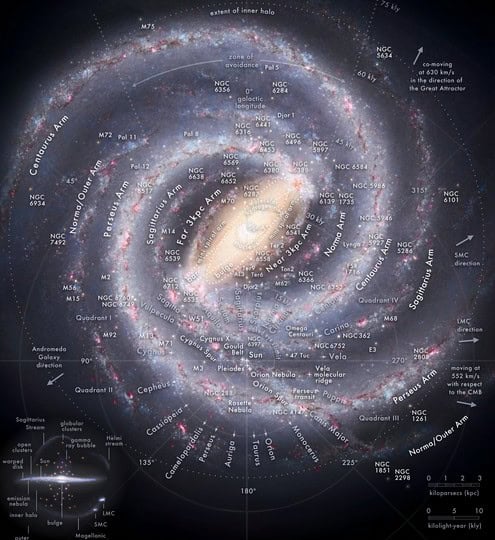The Milky Way is a galaxy that contains a vast collection of stars, planets, and other celestial objects. It is one of billions of galaxies in the universe. The Milky Way is home to our solar system, which includes the Earth and other planets. It gets its name from the hazy band of light that can be seen in the night sky, which is caused by the combined glow of billions of stars. The Milky Way is thought to be about 100,000 light-years in diameter and has a spiral shape. It is located in the Local Group, a cluster of galaxies that also includes the Andromeda Galaxy and the Triangulum Galaxy. Scientists believe that the Milky Way formed about 13.6 billion years ago, shortly after the Big Bang. The study of the Milky Way and other galaxies is an important area of research in the field of astronomy.
All dictionaries of the Russian language: Explanatory Dictionary, Dictionary of Synonyms, Dictionary of Antonyms, Encyclopedic Dictionary, Academic Dictionary, Dictionary of Nouns, Proverbs, Dictionary of Russian Argo, Orthographic Dictionary, Dictionary of Accents, Difficulties of Pronunciation and Emphasis, Word Forms, Synonyms, Thesaurus of Russian Business Lexicon, Morpheme-Orphographic Dictionary, Etymology, Etymological Dictionary, Grammatical Dictionary, Ideography, Proverbs and Sayings, Etymological Dictionary of the Russian Language.
Dear user, the site is developing and exists only on advertising revenue – please disable your ad blocker.
2. Resembling milk in appearance (in biology).
3. Containing a liquid similar to milk.
Ushakov’s Dictionary
MILKY Milky, milky.
1. Having the appearance of milk (church, lit., poet. obsolete).
2. Having a milk-like appearance (of plant sap; bot.). Milky liquid.
With a juice similar to milk (bot.). Milky vessels.
– Milky Way (astr.) – a collection of a vast number of stars, visible to the naked eye on clear nights as a bright band spanning across the sky.
Ozhegov’s Dictionary
2. Having the appearance of milk. M. sap (in certain plants).
Milky Way a constellation in the shape of a faint band that stretches across the starry sky.
Encyclopedic Dictionary
1. Verbal. = Milky (1 meaning).
2. Traditional. White, the color of milk. Milky brushes of bird cherry.
3. Resembling milk in some way; containing something that resembles milk (usually in compound terms). Milky sap (botanical; a liquid found in the stems, leaves, and roots of certain plants; latex). Milky vessels (botanical; = milky vessels).
◊ Milky Way. A group of stars that can be seen with the naked eye as a bright band crossing the sky on clear nights. // The formal name of our Galaxy. ● According to ancient Greek mythology, the Milky Way was formed by a stream of milk that sprayed into the sky from the breast of the goddess Hera.
Academic Dictionary
[Vesna-Krasna:] The way I perceive the happy valleys of the south is quite different – they are adorned with lush meadows and filled with the sweet scent of acacia. Moreover, the matte moon casts a lazy, milky glow over the surroundings. A. Ostrovsky, The Snow Maiden.
The river’s foam and splashes exhibit a distinct milky hue, a characteristic feature of rivers formed by glaciers. Semyonov-Tyan-Shansky, Journey to the Tien Shan.
A group of stars that is visible to the naked eye as a luminous streak across the sky on clear nights. According to Greek mythology, the Milky Way originated from a stream of milk that splashed into the sky from the breast of the goddess Hera.
A substance found in the stems, leaves, and roots of certain plants, resembling a liquid and known as latex.
Spelling Dictionary
Word forms for the word milky
milky, milky, milky, milky, milky, milky, milky, milky, milky, milky, milky, milky, milky, milky, milky, milky, milky, milky, milky, milky, milky, milky, milky, milky, milky, milky, milky, milky, milky, more milky, more milky, more milky, more milky, more milky, more milky, more milky
Alternative words for the term milky
Morpheme-Orphographic Thesaurus
Grammatical thesaurus
Etymological Thesaurus
path, Polish. mleczna ścieżka, German. Milchweg, French chemin lacté – the identical. These are all translations of Lat. vvia lactea, Greek κύκλος γαλαξίας from γάλα “milk”; refer to Pirchegger, ZfslPh 12, 303; Kretschmer, Glotta 22, 262 ff.
Useful services
Encyclopedic Dictionary
Milky blossom blight of fruit is a condition that affects apple, pear, plum, and other fruits. It is caused by a combination of wood freezing and parasitic fungi. The leaves and branches of the affected plants have a milky color with a pearlescent sheen. The affected fruits may either fall off prematurely or fail to develop.
Fruiting Milky Shine is another disease that affects apple, pear, plum, and other fruits. Similar to the milky blossom blight, it is caused by wood freezing and parasitic fungi. The leaves and branches of the affected plants also have a milky color with a pearlescent sheen. The affected fruits may either fall off prematurely or fail to develop.
FLASH OF Fruits is a condition that affects apple, pear, plum, and other fruit trees. It occurs when the wood freezes and is accompanied by the growth of parasitic fungi. The leaves and branches of affected trees have a milky color with a pearlescent sheen. As a result, the fruits either fall off prematurely or fail to develop.
Helpful Resources
Ozhegov’s Explanatory Dictionary
Encyclopedic Dictionary
The Milky Way is a celestial phenomenon that can be observed as a dimly luminous band crossing the starry sky. It is formed by a vast number of stars that are visually indistinguishable and concentrated along the main plane of our Galaxy. The Sun is situated relatively close to this plane, causing most of the stars in the Galaxy to appear within a narrow band known as the Milky Way on the celestial sphere.
Additionally, the term “Milky Way” is used to refer to our own Galaxy.
MILKY WAY – MILKY WAY
1) The Milky Way is a vast collection of stars that form a faintly glowing band across the night sky. This band is made up of an immense number of stars that are closely packed together along the main plane of our Galaxy. The Sun is located near this plane, which means that a majority of the stars in the Galaxy appear to us as if they are concentrated within a narrow strip known as the Milky Way.
2) The official designation for our Galaxy.
Extensive Encyclopedia Dictionary
The Milky Way -1) An indistinctly glowing strip that spans across the starry expanse. It showcases an immense multitude of visually indistinguishable stars that cluster together along the primary plane of the Galaxy. Near this plane lies the Sun, resulting in the majority of the Galaxy’s stars appearing to be concentrated within a narrow band known as the Milky Way. 2) The formal designation for the Galaxy itself.
Collier’s Encyclopedia
The Collier’s Encyclopedia is a comprehensive reference work that covers a wide range of topics.
It provides detailed information on various subjects, including history, geography, science, literature, arts, and more.
The encyclopedia is widely regarded as a reliable and authoritative source for information.
It has been a valuable resource for students, researchers, and general readers for many years.
With its extensive coverage and in-depth articles, the Collier’s Encyclopedia is a valuable tool for anyone seeking knowledge and information.

The Lund Observatory in Sweden has produced a comprehensive photographic map known as the Milky Way. The map captures the stunning beauty of our galaxy, with the Magellanic Clouds visible to the right and below the center.
Regrettably, Northern Hemisphere observers do not have access to the most brilliant sections of the Milky Way. In order to witness these incredible sights, one must journey to the equator or, even better, position themselves between 20 and 40°S and gaze at the sky around 10 pm in late April or early May. During this time, the Southern Cross can be seen high in the sky, while Sirius is visible in the northwest, albeit at a lower position. Between these two celestial objects lies the faint and narrow Milky Way, which becomes significantly brighter and more captivating 30° west of the Southern Cross, within the constellation of Kiel. As Sagittarius and Scorpius ascend in the eastern sky, the most dazzling and awe-inspiring sections of the Milky Way become visible. The most extraordinary region is observable late in the evening during the months of June and July when the Sagittarius Cloud is near the zenith. Against the uniform glow created by countless distant stars, which are impossible to distinguish with the naked eye, one can observe dark clouds and “veins” composed of frigid cosmic dust. Those who wish to comprehend the structure of our Galaxy should devote time to observing the Milky Way – this genuinely remarkable and supremely majestic celestial phenomenon.

The southern area of the Milky Way can be observed starting from the luminous h emission nebula of Kiel on the right, passing through the Southern Cross slightly to the right of the center, and continuing to the dark Coal Sack Nebula in the center, and finally reaching the stars b and a of Centaurus on the left.
Binoculars or a small telescope are sufficient to discern the countless stars that compose the Milky Way. The highest concentration of stars and the widest span of the Milky Way are observed in the constellations of Sagittarius and Scorpius; it is least populated with stars on the opposite side of the sky, near Orion’s Belt and Capella. Precise astronomical observations validate the initial visual impression: the Milky Way band signifies the central plane of a colossal disk-shaped stellar system – our Galaxy, frequently referred to as the Milky Way Galaxy. One of its stars is our Sun, situated in close proximity to the galaxy’s central plane. However, the Sun does not reside at the center of the galactic disk, but rather at a distance of two-thirds from its center to its edge. The stars that constitute the Milky Way are situated at various distances from Earth: some are no more than 100 light-years away, while most are 10,000 light-years or even farther away. The star cloud in Sagittarius and Scorpius indicates the direction to the Galaxy’s center, which is approximately 30,000 light-years from Earth. The diameter of the entire Galaxy is at least 100,000 light-years.
CONNECTION. A galaxy possesses a minimum mass of 2*10 11 solar masses. It consists primarily of stars, although 5% of its mass is comprised of interstellar matter, including gas and dust. Interstellar matter occupies the space between stars within a galactic disk that is approximately 600 sv. years in thickness. Additionally, within the disk, interstellar matter is concentrated in the spiral arms of the Galaxy. A significant portion of the interstellar matter clusters together in large, frigid clouds, within which star formation occurs.
Check out INTERSTELLAR Matter as well. The Milky Way Galaxy is just one of the many star systems that have been discovered in the Universe using powerful telescopes. It is often referred to as “our star system”. It is a large galaxy with rapid rotation and noticeable spiral arms, which are home to young, hot stars and clouds of gas that are heated by their radiation, known as “emission nebulae”. Optical telescopes are unable to fully study the entire Galaxy due to the dense interstellar clouds of gas and dust, particularly concentrated towards the center of the Galaxy. However, these obstacles do not hinder the study of infrared radiation and radio emission. With the help of specialized telescopes, scientists are able to explore the entire Galaxy and even penetrate its dense core. Through observations, it has been determined that stars and gas in the galactic disk move at a speed of approximately 250 km/s around the center of the Galaxy. Our Sun, along with the planets, also moves at this speed, completing one revolution around the galactic center every 200 million years.
Illustrated Encyclopedic Dictionary
1) A faintly glowing line that stretches across the night sky. It signifies an immense collection of stars that appear visually identical and are densely packed in the central region of the Galaxy. The position of the Sun is in proximity to this region, causing the majority of the Galaxy’s stars to be projected onto the celestial sphere in a narrow strip – known as the Milky Way.
2) The formal designation for our Galaxy.
Dictionary of Idioms
A collection of numerous dim stars and nebulae, appearing to the naked eye as a shapeless strip of light extending across the sky.
The Milky Way gleamed like a faint pinkish glow (Goncharov. Frigate “Pallada”).
The silvery fabric of the Milky Way spread across the entire sky (M. Gorky. Troy).
Over the garden, sparkling in the ponds, numerous stars emerged, and the Milky Way shimmered with hazy light (A. N. Tolstoy. Count Cagliostro).





